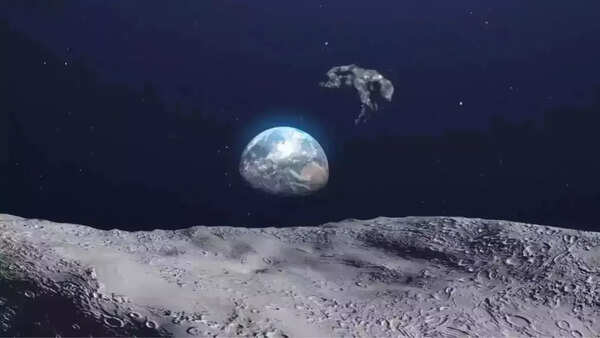‘City killer’ asteroid may hit the Moon in December 2032 could threaten satellites around Earth; experts warn
A city-killer asteroid, known as 2024 YR4, is not expected to strike Earth. However, scientists are increasingly concerned about a potential collision with the Moon. Experts at the University of Western Ontario warn that such an impact could eject over 100 million kilograms of debris into space. This fast-moving lunar material poses a significant threat to satellites in low Earth orbit (LEO), which are crucial for communication, GPS, climate observation, and even the astronauts aboard the International Space Station (ISS). Given the increasing number of satellite networks and human space activities, the potential consequences of an asteroid impact on the Moon warrant immediate international attention and preparedness.
Initial monitoring of asteroid 2024 YR4 suggested a potential threat to Earth. However, further observations have ruled out a direct impact. Simulations now indicate a higher probability of the asteroid striking the Moon, with chances increasing from 3.8% to 4.3%. While this percentage may seem low, it is sufficient for scientists to closely monitor the asteroid's trajectory and simulate potential impacts.
Should the asteroid collide with the Moon, the resulting energy release could be equivalent to 6.5 megatons of TNT, exceeding the force of the Hiroshima bomb by more than 400 times. The impact could create a crater approximately 1 kilometer wide, likely in the Moon's southern hemisphere.

The collision is projected to send approximately 100 million kilograms of lunar rock and dust into space. Of particular concern is that roughly 10% of this lunar debris could reach Earth within days of the impact. While most of the debris will be minuscule, particles larger than 0.1 millimeters could potentially penetrate or damage satellites and spacecraft. These particles would remain in orbit, posing a long-term risk to space-based infrastructure.
Increased Orbital Traffic Heightens Risk from Asteroid Impact
The number of satellites orbiting Earth is expected to increase significantly by 2032 due to the global expansion of telecommunications, navigation, and Earth observation technologies. The majority of these satellites will reside in low Earth orbit (LEO), the same region that would be affected by debris resulting from a lunar impact.
The University of Western Ontario team conducted 10,000 impact simulations. In 410 of these simulations, the asteroid directly struck the Moon, resulting in high concentrations of potentially destructive space debris in the following days. While the study does not explicitly assess the risk to human space missions, the ISS also orbits in LEO, making it a potential target. Even small, high-speed debris particles have the potential to cause catastrophic damage to spacecraft and endanger astronauts' lives.

Variables Influencing Threat Distribution
Scientists emphasize that the magnitude and distribution of the threat depend on several factors:
- Impact location on the Moon
- Asteroid speed and trajectory
- Size of the resulting crater
- Distribution and velocity of ejected debris
- Combinations of these variables will influence the amount of debris that escapes the Moon's gravity and reaches Earth's vicinity.
Earth May Be Safe, but Satellites Are Vulnerable
Despite Earth not being in the asteroid's path, the potential indirect consequences of a lunar collision are significant enough to warrant preparation. Modern society relies heavily on satellites for essential services, including GPS, internet access, climate monitoring, and scientific data. Any disruption to this orbital infrastructure could have global ramifications.
This potential impact serves as a call to action for space agencies to invest in orbital debris tracking, satellite shielding, and advanced risk prediction technologies. While asteroid 2024 YR4 may not directly threaten Earth, its impact on the Moon could create chaos in our orbital environment. The possibility of over 100 million kilograms of space debris entering Earth's orbit highlights the interconnectedness of celestial bodies and the importance of monitoring even distant space threats.
Newer articles
-
 Suchitra Krishnamoorthi faces backlash for claiming Air India crash survivor was ‘LYING’; Deletes post and issues apology
Suchitra Krishnamoorthi faces backlash for claiming Air India crash survivor was ‘LYING’; Deletes post and issues apology
-
 Is Mohanlal, Mammootty, Mahesh Narayanan’s project titled ‘Patriot’? - Here’s what we know
Is Mohanlal, Mammootty, Mahesh Narayanan’s project titled ‘Patriot’? - Here’s what we know
-
 Mahbub Anam replaces Faruque Ahmed as new BPL chairman
Mahbub Anam replaces Faruque Ahmed as new BPL chairman
-
 Still swooning over Ahn Hyo Seop and Kim Sejeong in ‘Business Proposal’? Here are 3 new K-Dramas to obsess over next!
Still swooning over Ahn Hyo Seop and Kim Sejeong in ‘Business Proposal’? Here are 3 new K-Dramas to obsess over next!
-
 Pope retains No.3 spot; Carse set for home 'debut'
Pope retains No.3 spot; Carse set for home 'debut'
-
 Ngarava, Curran and Raza to miss Test series against South Africa
Ngarava, Curran and Raza to miss Test series against South Africa
-
 'Would be remarkable to choose someone else if their last knock was a 170'
'Would be remarkable to choose someone else if their last knock was a 170'
-
 India vs England: Can Bazball outplay India's new era? Key battles and what to expect
India vs England: Can Bazball outplay India's new era? Key battles and what to expect
-
 Will Nysa Devgan enter Bollywood like Raveena Tandon's daughter Rasha Thadani? Kajol reveals the truth
Will Nysa Devgan enter Bollywood like Raveena Tandon's daughter Rasha Thadani? Kajol reveals the truth
-
 'Prince and Family' OTT release: When and where to watch Dileep's comedy drama
'Prince and Family' OTT release: When and where to watch Dileep's comedy drama